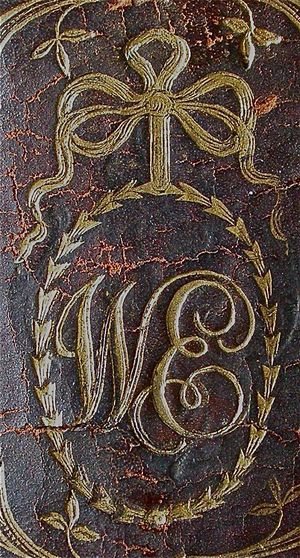William Erskine 1728-1795
Sir William ERSKINE, 1st baronet 1728-1795
Biographical Note
Son of Colonel William Erskine of Torrie, Fife, deputy governor of Blackness Castle. He joined his father's regiment in the Army in 1742 and saw action in the Seven Years War and other European conflicts; he was promoted Lieutenant-Colonel, and knighted, in 1762. In 1776 he was posted to America and was a Major General by 1779, subsequently serving in senior positions in the Wars of the French Revolution. He remained in active service more or less up to the time of his death, and was made a baronet in 1791. His principal seat was at Torryburn, where he built Torrie House overlooking the Firth of Forth. The family also had estates at Largo, Spencerfield and Dunino, south of St Andrews.
Books
A family library was developed primarily by Sir William and his sons and daughters, although a few books were inherited from previous generations and a small set of some 50 items appears to have been inherited, in the early 19th century, from a neighbour, Captain James Ker; this set includes a number of early law books belonging to various related families particularly the Halkerstons.
The library consists of around 2000 titles in some 4500 volumes. Although the dates of publication range from 1552 to the 1870s, over three-quarters of the books were published between the 1750s and the 1830s. Similarly, although several languages are represented including both European and South Asian ones, over 80% of the books are in English. The subject coverage is broad: agriculture, history, geography, travel and exploration, classical and modern literature, news, politics, law, music, military history and economics, memoirs, philosophy and religion, a small number of scientific items and a significant collection of works on south Asia and the East India Company. The library was added to after the death of the youngest son, John Drummond Erskine (1776-1836) but only slowly. These mainly belonged to the youngest daughter Magdalene Sharpe-Erskine (1787-1872). At her death the library went into a trust, the Erskine of Torrie Institution, and was not added to after that. The library now constitutes the Dunimarle Library, part of the Dunimarle Collection, housed at Duff House, Banff. Duff House is in the care of Historic Environment Scotland and the Collection is on long term loan from the Erskine of Torrie Institution.
Characteristic Markings
Roughly 45% of the books have some form of ownership mark. The most significant family ones are of those Sir William and of John Drummond Erskine, the latter being the most prominent collector. Neither used bookplates but Sir William had monogrammed spines, John only inscribed – using various forms of his name. He both annotated his books and often wrote his name, the date and a place on them. His interests were broad with a particular emphasis (in terms of annotations at least) on language, economics and many aspects of the Indian subcontinent. The last is one of the features of the library ie a collection of some 350 books which are either related to India or have evidence that John collected the titles while he was there including a number of works in Persian.
Sources
- Sir William Erskine, Wikipedia.
- British Armorial Bindings.
- Buddle, Anne [ed.] The Dunimarle Collection at Duff House, Historic Environment Scotland, 2018.
- Cumming, Sandra, Book evidence as a possible tool in history of education research: the children's collection in the Dunimarle Library, in History of Education Researcher, No. 100, November 2017.
- Stephens, H. M., and Roger T. Stearn. "Erskine, Sir William, second baronet (1770–1813), army officer." Oxford Dictionary of National Biography.
- Information from Sandra Cumming.
